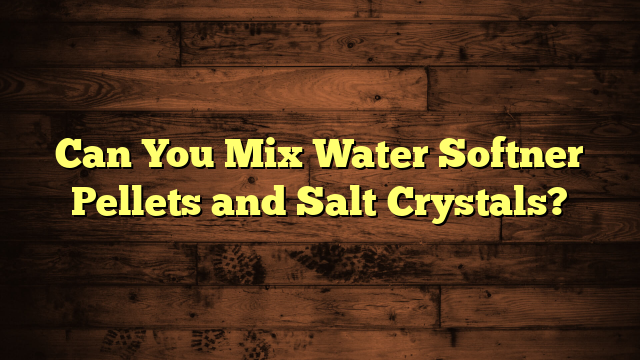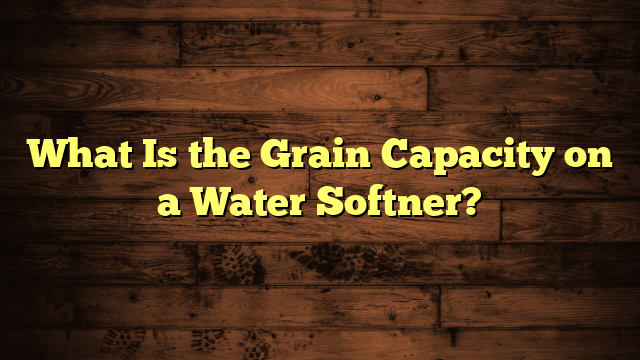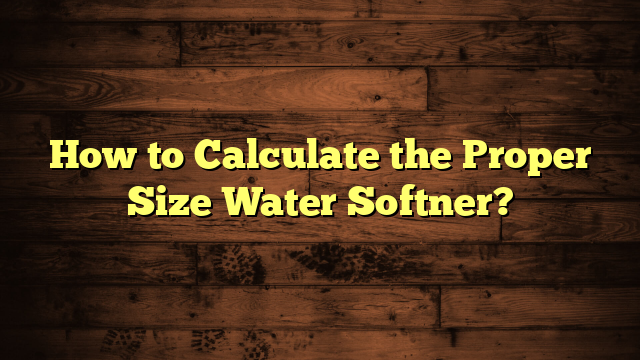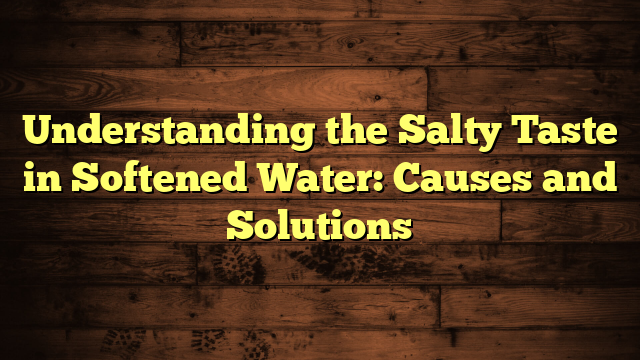Can You Mix Water Softner Pellets and Salt Crystals?
Is it true that mixing water softener pellets and salt crystals can optimize your water softening system? While some might suggest that combining these two types of salt could enhance performance, it's crucial to take into account the potential complications that could arise. You'll want to understand both the benefits and drawbacks before making any changes to your water softening regimen. Could the wrong mix lead to more maintenance issues than advantages? Let's explore this topic further to help you make an informed decision.
Key Takeaways
- Mixing water softener pellets and salt crystals can enhance efficiency but requires careful ratio management to avoid clumping.
- Pellets provide a steady release of sodium ions, while crystals dissolve quickly, creating a potential synergy.
- Clumping from mixed salt may lead to blockages in the system and hinder effective softening.
- Increased maintenance checks and cleanings may be necessary when mixing pellets and crystals to ensure optimal performance.
- Using high-quality salt types, like evaporated or solar, can improve dissolution and minimize issues when mixing.
Understanding Water Softener Basics
Water softeners are essential devices that help eliminate hard minerals like calcium and magnesium from your water supply. Understanding water softener functionality is vital for maintaining your home's plumbing and improving water quality.
At the heart of these systems is a process called ion exchange, where hard minerals are swapped for softer ones, usually sodium or potassium ions.
When you set up your water softener, it contains resin beads that attract and hold onto the hard minerals. As water flows through the system, these beads release sodium ions, effectively softening the water.
Over time, the resin beads become saturated with calcium and magnesium, which means they need to be recharged. This is where salt comes into play; during the regeneration process, salt is dissolved in water, replenishing the sodium ions on the resin beads.
Types of Water Softener Salt
Choosing the right type of salt for your water softener can greatly impact its performance. There are several options available, each with its own benefits and considerations. The most common types include rock salt, solar salt, and evaporated salt.
Rock salt is generally the least expensive option, but it may contain impurities that can affect water quality and lead to mineral buildup in your system.
On the other hand, solar salt is produced through evaporating seawater, resulting in a purer product. This type is often recommended for its effectiveness in minimizing impurities that could clog your system.
Lastly, evaporated salt is the purest form, with minimal impurities, making it an excellent choice for those who prioritize ideal water quality. It dissolves quickly, reducing the risk of any mineral buildup in your water softener.
When selecting the right salt for your water softener, consider your specific needs and the quality of water in your area.
Benefits of Water Softener Pellets
If you're considering options for your water softener, water softener pellets offer several distinct advantages. One of the primary pellet advantages is their ability to enhance water softener efficiency. Unlike traditional salt crystals, pellets dissolve more uniformly, ensuring a consistent release of sodium ions into the water. This uniformity translates to effective softening, reducing the chances of buildup in your system.
Additionally, pellets are less prone to bridging, a common issue with salt crystals, where the salt forms a solid mass that can hinder performance. This means you won't have to worry as much about maintenance or troubleshooting your water softener.
Another benefit you might appreciate is the ease of use. Water softener pellets are usually easier to handle and store, making the refilling process straightforward and less messy. Their compact nature often means less packaging waste, so they're also a more environmentally friendly option.
Advantages of Salt Crystals
When it comes to salt crystals, one significant advantage is their cost-effectiveness. You'll find that salt crystals often come at a lower price point compared to other water softening options. This means you can save money while still effectively reducing hard water issues in your home.
Furthermore, salt crystal advantages extend beyond just price; they also provide excellent performance in softening water. You'll appreciate the salt efficiency benefits, as these crystals dissolve effectively in water, ensuring peak performance in your softening system. This efficiency translates into fewer maintenance issues and less frequent need for replenishment.
In addition, salt crystals are generally easy to handle and store, making them convenient for everyday use. Another perk of using salt crystals is their availability. You can easily find them at local stores or online, which means you won't have to search far for a reliable supply.
With these benefits in mind, it's clear that salt crystals offer a practical and economical solution for your water softening needs. Overall, choosing salt crystals can lead to significant savings and effective water treatment for your household.
Compatibility of Pellets and Crystals
Mixing water softener pellets and salt crystals can be a practical approach to enhancing your water treatment system. The compatibility of these two forms of salt can lead to improved performance and efficiency.
You'll find that pellet advantages lie in their ability to dissolve slowly, which provides a steady release of sodium ions. This gradual process helps maintain consistent water softness over time.
On the other hand, salt crystals are known for their crystal efficiency, dissolving quickly and effectively during regeneration cycles. When you combine these two, you can enjoy the benefits of both: the sustained performance of pellets and the rapid action of crystals.
This synergy can optimize your water softening system, potentially leading to less frequent maintenance and longer-lasting results.
However, you'll want to keep an eye on the ratios you use. By mixing the right amounts of both pellets and crystals, you can achieve a balance that maximizes their individual strengths without compromising overall effectiveness.
Potential Issues With Mixing
Mixing water softener pellets and salt crystals might seem convenient, but it can lead to some significant issues.
The differences in their chemical compositions can affect your system's performance, and you may face unexpected maintenance challenges ahead.
It's crucial to understand these potential problems before you decide to combine them in your water softener.
Chemical Composition Differences
Understanding the chemical composition differences between water softener pellets and salt crystals is essential for effective water treatment. Water softener pellets typically contain sodium chloride but may also include additional chemicals to enhance their softening capabilities. These additives can alter the chemical properties of the pellets, affecting how they interact with minerals in your water.
On the other hand, salt crystals, usually made of pure sodium chloride, have a different mineral content. When you mix these two types, you risk compromising the overall effectiveness of your water softening system. The added chemicals in the pellets could react unpredictably with the salt crystals, potentially leading to unwanted byproducts.
Furthermore, the varying solubility rates can create uneven distribution in your water softening system, which may lead to inconsistent performance. If you're relying on a balanced chemical composition for ideal softening, mixing these two can throw that balance off.
System Performance Impact
Combining water softener pellets and salt crystals can lead to significant issues in system performance. When you mix these two types of salt, it can disrupt your water softener's efficiency. Each ingredient has a specific role, and combining them may create competition for the resin beads in your system. This can reduce the overall system efficiency, making it work harder than necessary to achieve the desired water quality.
Moreover, the difference in solubility rates can cause uneven dissolution in the brine tank. This uneven mixing can lead to an inconsistent salt concentration during regeneration cycles. If your system doesn't receive the right balance, you may notice a decline in water quality, leading to scale buildup and hard water issues in your plumbing and appliances.
In the long run, these performance impacts can result in more frequent cycles and increased energy consumption.
Maintenance Challenges Ahead
Many homeowners face maintenance challenges when they mix water softener pellets and salt crystals. This combination can lead to several issues that may complicate your water softener maintenance routine. For instance, the different dissolution rates of these materials can create blockages in your system, resulting in reduced efficiency. You might also notice that the salt storage solutions you've implemented may not work as well due to varying moisture absorption properties.
Here's a quick overview of potential issues:
| Issue | Description |
|---|---|
| Blockages | Mixing can form clumps, clogging the system. |
| Inefficient Softening | Different dissolve rates affect softening. |
| Increased Maintenance Needs | More frequent checks and cleaning may be essential. |
| Cost Implications | Potentially higher costs due to repairs. |
To avoid these challenges, consider using one type of product at a time. Regularly monitor your system's performance, and verify your salt storage solutions are well-suited for the type of salt you're using. By staying proactive, you'll maintain superior performance and extend your water softener's lifespan.
Best Practices for Salt Use
When it comes to using salt for your water softener, choosing the right type is essential for peak performance.
You'll want to understand the differences between salt types and follow some straightforward mixing guidelines to guarantee your system runs smoothly.
Salt Types Comparison
While selecting the right salt for your water softener, it's crucial to understand the differences between the various types available. You'll typically come across two main options: salt crystals and pellets. Each has distinct salt properties that can impact your water softener's performance.
Salt crystals are often less expensive and dissolve quickly but may leave behind residue if not used properly. They can sometimes lead to bridging in the brine tank, causing inefficiencies.
On the other hand, water softener pellets have several pellet advantages. They're designed to dissolve slowly, guaranteeing a consistent supply of brine for the softening process. This slow dissolution minimizes residue buildup and reduces the chances of bridging.
When considering your options, think about the specific needs of your water softener system. If you want something that guarantees a smoother operation, pellets might be the better choice.
However, if you're on a budget and can manage the maintenance, crystals could work for you. Remember that understanding these differences can help you make informed decisions and keep your water softener running efficiently.
Optimal Mixing Guidelines
To achieve the best results with your water softener, it's essential to follow ideal mixing guidelines for salt use. By applying ideal mixing techniques, you'll guarantee that your water softener operates efficiently and effectively.
Here are some best practices to keep in mind:
- Choose high-quality salt: Opt for evaporated salt or solar salt, as they dissolve better and minimize impurities.
- Monitor salt saturation levels: Regularly check how much salt is in your brine tank, and refill when it drops below the recommended level.
- Avoid mixing types too frequently: If you decide to mix water softener pellets and salt crystals, do so sparingly to prevent clumping and guarantee even distribution.
- Clean your brine tank: Periodically remove any sediment or buildup, as this can interfere with the mixing process and affect performance.
Recommendations for Homeowners
Homeowners should consider a few key recommendations when mixing water softener pellets and salt crystals to guarantee peak performance of their water softening system. Following these tips can help assure your system runs efficiently and effectively.
| Recommendation | Details | Benefits |
|---|---|---|
| Use Compatible Products | Always check the manufacturer's guidelines. | Prevents system damage. |
| Monitor Salt Levels | Regularly check and refill as needed. | Maintains ideal performance. |
| Clean Brine Tank | Schedule routine cleanings every few months. | Assures longevity and efficiency. |
| Adjust Salt Type | Experiment with different types if needed. | Maximizes softening capabilities. |
| Follow Water Softener Maintenance | Keep an eye on your system's settings. | Reduces repair costs in the long run. |
Frequently Asked Questions
Can Mixing Pellets and Crystals Damage My Water Softener?
Mixing pellets and crystals can impact your water softener's performance. For ideal water softener maintenance and salt usage efficiency, it's best to stick with one type of product to guarantee effective results and prevent potential damage.
How Often Should I Add Salt or Pellets?
You should follow salt dosage guidelines based on your water softener's capacity. Regularly check your maintenance schedule; typically, adding salt or pellets every 4 to 6 weeks keeps your system running efficiently and effectively.
Are There Specific Brands to Avoid When Mixing?
When it comes to mixing products, think of it like a recipe—some brands just don't blend well. Check brand recommendations and product comparisons to avoid clumping or inefficiency in your water softening system.
What Happens if I Run Out of One Type?
If you run out of one type, your water softener's effectiveness may decline. Consider salt alternatives to keep up with water softener maintenance, ensuring peak performance until you restock your preferred supply.
Can I Use Other Types of Salt With Water Softeners?
Imagine running low on salt; you wonder if other types could work. Alternative salt options can enhance softener efficiency, but always check your system's compatibility. Some salts might not dissolve effectively, affecting your water quality.
Conclusion
To sum up, while mixing water softener pellets and salt crystals might seem like a shortcut to soft water bliss, it's a bit like trying to bake a cake with two different recipes at once—messy and likely to leave you with a flop. By sticking to manufacturer guidelines and keeping an eye on your salt levels, you can guarantee your system runs smoothly. So, let's leave the mixing to the chefs and keep your water softener happy and efficient!







